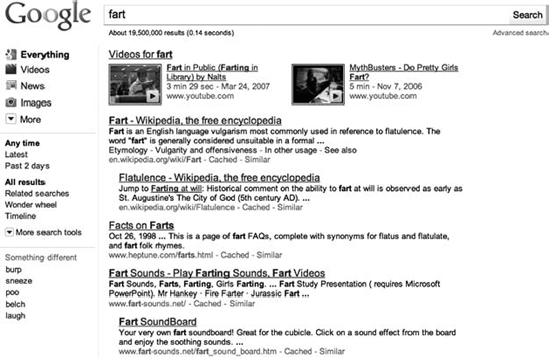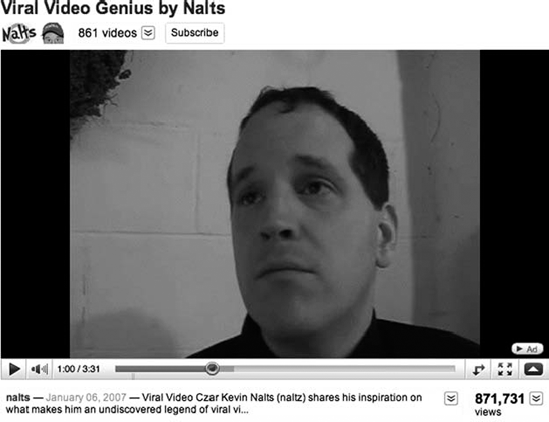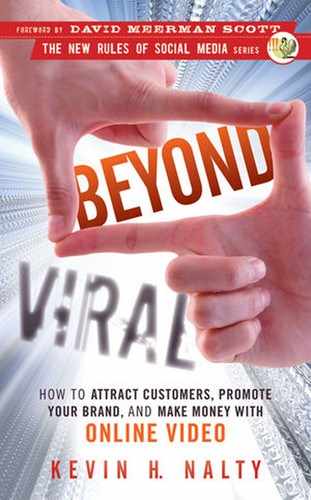A great author, especially a marketer, would spare no words before telling you why this book is so vital to you. Alas, I'm not a great author. Unlike those behind the other books adorning your shelves, I am perhaps more like you. What I lack in raw talent I make up for in voracious curiosity and persistence. I don't exercise or floss daily, but I thrive on disruptive change and have a passion for lifelong learning.
I have written this book because I feel that most books about online video have missed the mark. I'll offer four theories: (1) The medium is changing so rapidly that none of us understand it entirely; (2) the majority of YouTube books are simply dull how-to instructions; (3) many books focus on video production and not business implications; and (4) some are written by writers. We have already established that I am not a writer, and if you decide otherwise, the editors deserve credit. I am a career marketer, a dad, a video enthusiast, and someone who happens to have fooled millions of online-video viewers into thinking I am a celebrity.
Online video offers profound opportunities for people and businesses, and I hope this book can be your shortcut to seizing them. As both a career marketer and online-video creator, I have participated actively in this new medium since 2005 (the year YouTube launched). I have watched, studied, and analyzed this ecosystem somewhat compulsively, as my family might observe. I regularly speak at industry conferences, educate marketers, and write about it via my blog (WillVideoForFood.com) and in trade publications. My journey, which was chronicled in a documentary titled "I Want My Three Minutes Back," is something I hope can save you time (Figure I.1). I also have engaged in online video as a full-time marketing director at Johnson & Johnson and Merck, and with such clients as Coke, Microsoft, General Electric, Fox Broadcasting, Starbucks, Holiday Inn, Mentos, and MTV.

Figure 1. A YouTube documentary, "I Want My Three Minutes Back," chronicles the author's misadventures, seen here with his 14-year-old prankster, Spencer.
I tell you this not just to brag, but to let you know you are holding a compressed file representing thousands of hours of research and experience. Unzip it to save yourself time, catch up, avoid pitfalls, and zoom past competitors. Or read it cover-to-cover if you feel so inclined. But please at least read the first chapters, and then dive into practical insights that can specifically help you in your business, artistic, volunteer, or other pursuits.
In addition to setting your expectations about my writing, I need to make two additional disclaimers. First, I am not the brightest marketer (although at least I am enlightened to that fact). Second, I am far from the most talented or popular online-video creator. I am, however, the only career marketer today who is also one of the most-viewed personalities on YouTube. My more than 1,000 videos have been seen hundreds of millions of times. They're lowbrow humor—Doritos™ for the brain, if you will. But surprisingly, more people watch them each day than some of the television shows you know well. My videos range from sophomoric candid-camera-style pranks to heartfelt family moments. My mom takes little pride in knowing they can find my opus video ("Farting in Public") by simply searching Google for the word fart. (See Figure I.2.)
Lest you think my YouTube fame has gone to my head, let me be clear it does not carry many special privileges or bring me great fortune. I playfully call myself a viral video genius, or weblebrity. Of course, I have only been recognized in public a total of three times (each time more thrilling to me than the viewer). My 15 minutes of fame has lasted longer than I might have anticipated, however; it has allowed me to meet some real-life stars, and that's been a real treat. But you won't see me on red carpets or at the Hollywood parties. My income as a YouTube Partner, while not trivial, is not enough to substantiate a family of six.

Figure 2. YouTube is the second-most popular search engine after Google. A Google search of the word "Fart" reveals the author's "Farting in Public" video on YouTube.
I make comedic-like videos. I can't call my videos comedy any more than Kraft™ can refer to its "cheese products" as actual cheese. Fortunately, my wife and family have tolerated this hobby because it does create nontrivial income. More important, studying and practicing online video is what I would be doing even if I won the lottery. I am combining two of my strongest passions (besides family, of course): marketing and online video.
There is great irony in my writing a book that includes viral in the title. Viral is a term that originated to refer to a biological agent (an infectious agent that can replicate inside the cells of other organisms). It was later used to refer to computer programs (usually harmful) that could infect a computer through reproductive processes. Marketers in the mid-1990s borrowed the term to describe marketing and advertising that would go viral via word-of-mouth or through preexisting social mediums. As videos became easier to share via e-mail and online-video web sites in the late 1990s, certain video clips became widely circulated, and the term viral video was born.
Leave it to us marketers, who refer to customers as "targets," to turn an infectious agent into a noble pursuit. Most viral videos are funny or bizarre clips created by individuals. One of the first examples of a viral video featured a crude webcam video by Gary Brolsma, a New Jersey teenager. Brolsma lip-synched to a song called "Dragostea Din Tei" by a Romanian band O-Zone, which contained the refrain "Numa Numa." He submitted the clip to Newgrounds.com in December 2004, and it was widely circulated and featured on many popular television shows.[2] (See Figure I.3.)
One of my first viral videos was, in fact, a mockery of viral. In a self-deprecating video called "Viral Video Genius," I parodied the pomposity of celebrated artists as if going viral actually mattered. (See Figure I.4.) I have since proclaimed viral dead, at least for advertisers. I should add that being viewed millions of times is a bit less satisfying than you might expect.
When I speak, I often beg marketers to go beyond the roulette game of a viral advertisement, since there are many smarter ways to tap online video to reach target customers and drive sales. If you picked up this book hoping to go viral, I hope to walk you down a road less traveled, where the grass is most definitely greener.

Figure 4. "The Author's "Viral Video Genius" spoofs a documentary interview of a self-important artist boasting of his viral-video success. When it was featured on YouTube's home page in 2007, those not watching the complete video took it seriously.
My passion, combined with my unique role as a hybrid career marketer and weblebrity, gives me a unique peek into how small companies and large brands can engage successfully in online video. Certainly, my marketing skills have given me an edge over more talented video creators (and to appease my guilty conscience, I once published a free e-book called How to Become Popular on YouTube Without Any Talent). I lost money on each copy, but made it up in volume when TechCrunch, a group-edited blog about technology start-ups, featured it.[3]
This bilingual nature—my ability to speak about online video as a marketer and as an entertainer—has helped my employers and clients. But for years, I have wanted to more broadly influence the online-video strategy and tactics pursued by businesses, marketers, advertisers, studios, and agencies. Last year, I resigned as a product director at Merck and Co., Inc., in what Cracked.com called one of the "ballsiest" resignations ever.[4] Before working at Merck, I was a leader at Johnson & Johnson, interactive agencies, and Big Five consulting. Now, I am merging my passions via Nalts Consulting (www.NaltsConsulting.com).
That's enough about me (at least for now). If you can absorb this book, and apply its strategies and suggestions, you'll be better off than the majority of businesses and my fellow marketers, who seem doomed to repeat the many failed attempts of others in this medium. I wish I could upload my experience in its entirety for instant download. Since that is not yet possible, I have done my best to distill what I've learned the hard way, and give you useful tips to engage your target audience, market your business or service, and increase sales. If you do, please let me know. My e-mail is [email protected], and I would be thrilled to learn how this book helped you.

